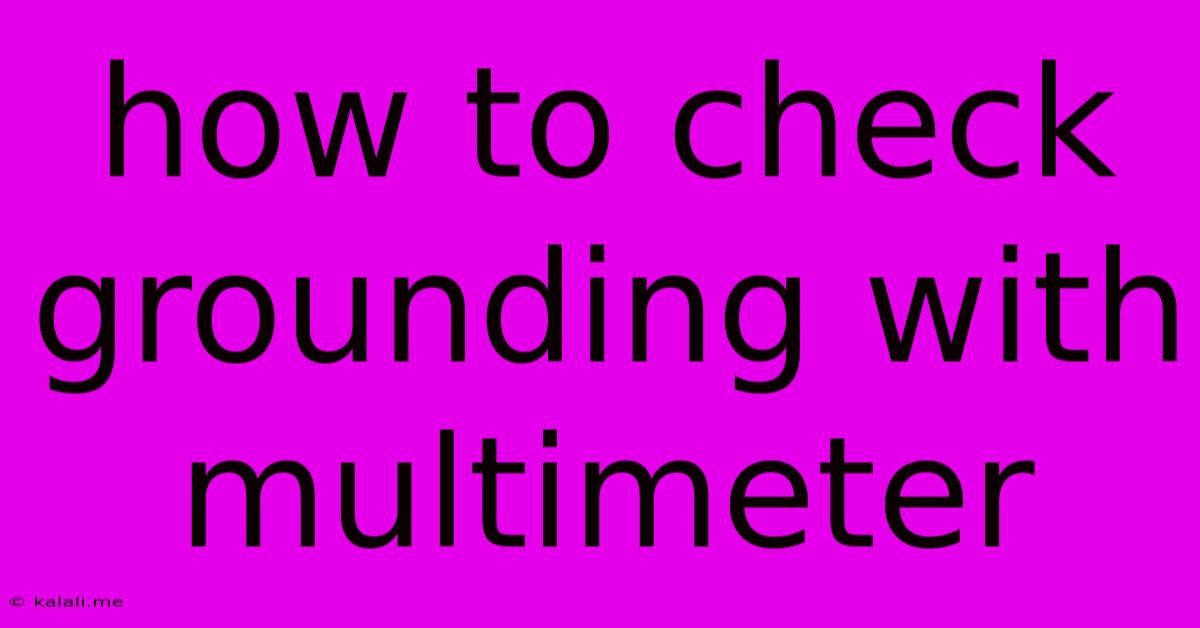How To Check Grounding With Multimeter
Kalali
Jun 05, 2025 · 4 min read

Table of Contents
How to Check Grounding with a Multimeter: A Comprehensive Guide
Ensuring proper grounding in your electrical system is crucial for safety and preventing electrical shocks. A faulty ground can lead to malfunctioning appliances, fire hazards, and even electrocution. This guide will walk you through how to effectively check your grounding using a multimeter, a vital tool for any homeowner or electrician. This detailed explanation covers various testing methods and safety precautions, allowing you to confidently assess the integrity of your electrical grounding system.
Understanding Grounding and its Importance
Before diving into the testing procedures, let's clarify what grounding is. Grounding provides a low-resistance path for fault currents to flow back to the earth, preventing dangerous voltage buildup on metal enclosures of appliances and electrical panels. A properly grounded system protects you from electrical shocks by diverting excess current safely away from you. Regular grounding checks are essential for maintaining a safe electrical environment in your home or workplace.
Safety First: Essential Precautions Before Testing
Electrical work inherently involves risks. Prioritize safety by following these precautions:
- Turn off the power: Before commencing any testing, always switch off the power at the breaker box to the circuit you are testing. Double-check the power is off using a non-contact voltage tester.
- Use insulated tools: Employ insulated screwdrivers and pliers to prevent accidental shocks.
- Wear safety glasses: Protect your eyes from potential sparks or debris.
- Work with a partner: If possible, have another person present to assist and ensure your safety.
- Know your limits: If you are unsure about any aspect of the process, consult a qualified electrician. This is especially important for complex electrical systems.
Equipment You'll Need
To perform a grounding check, you will need:
- A multimeter: This essential tool measures voltage, current, and resistance. Ensure it's in good working order and appropriately rated for the voltage in your system.
- Test leads: These connect the multimeter to the points you are testing. Make sure the leads are properly insulated.
- Screwdriver (insulated): For accessing grounding screws and connections.
- Non-contact voltage tester: To verify the power is truly off before starting.
Methods for Checking Grounding with a Multimeter
There are several methods to check grounding, depending on the specific situation and what you are trying to assess:
1. Checking Ground Resistance
This method measures the resistance between the grounding wire and the earth. A low resistance indicates a good ground.
- Set your multimeter: Select the ohms (Ω) range on your multimeter. Start with a lower range and increase if necessary.
- Connect the leads: Connect one multimeter lead to the grounding wire (usually green or bare copper) and the other lead to a known good ground (such as a metal water pipe – ensure it’s not plastic!).
- Take the reading: The multimeter will display the resistance in ohms. A reading below 5 ohms is generally considered acceptable, but the ideal value can vary depending on local codes and regulations. Higher readings indicate a poor ground connection.
2. Checking Ground Continuity
This method checks for a continuous path from the grounding point to the earth.
- Set your multimeter to continuity mode: This is usually symbolized by a diode icon.
- Connect the leads: Connect one lead to the grounding wire and the other lead to a known good ground (again, a metal water pipe is usually suitable).
- Check for continuity: The multimeter should beep or display a continuity indication if a good connection exists. The absence of a beep indicates a break in the grounding path.
3. Checking Voltage to Ground
This method assesses the voltage difference between the grounded point and the earth. It's crucial to ensure the power is completely off before performing this test.
- Set your multimeter to measure voltage (AC): Ensure you have it set to the appropriate voltage range for your system.
- Connect the leads: Connect one lead to the grounding wire and the other lead to a known good ground.
- Take the reading: The reading should be close to zero volts. A significant voltage reading indicates a problem with your grounding.
Interpreting Your Results and Next Steps
After performing the tests, interpret the results based on the methods described above. If you encounter high resistance, lack of continuity, or a significant voltage reading, it indicates a grounding problem. Addressing these issues is crucial to ensure electrical safety. Contact a qualified electrician to resolve the problem; attempting complex electrical repairs without the necessary expertise can be dangerous.
By following these steps and safety precautions, you can confidently check your grounding with a multimeter and maintain a safe electrical environment. Remember, prioritizing safety and seeking professional help when needed is paramount.
Latest Posts
Latest Posts
-
Are We All Descendants From Noah
Jun 06, 2025
-
How To Wire A Ceiling Fan With Remote
Jun 06, 2025
-
American Cant Check In Put Names Together
Jun 06, 2025
-
I Am Sorry To Hear That
Jun 06, 2025
-
Fnv Dead Money How To Turn Off Doors
Jun 06, 2025
Related Post
Thank you for visiting our website which covers about How To Check Grounding With Multimeter . We hope the information provided has been useful to you. Feel free to contact us if you have any questions or need further assistance. See you next time and don't miss to bookmark.